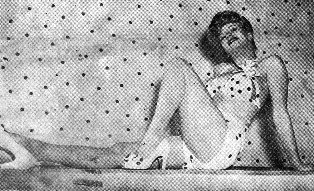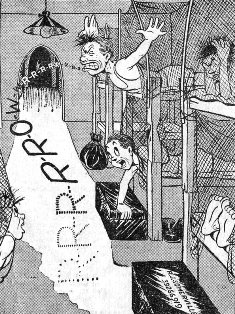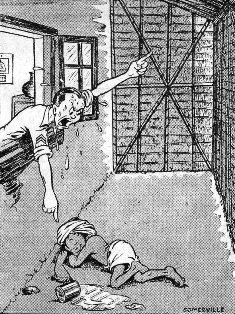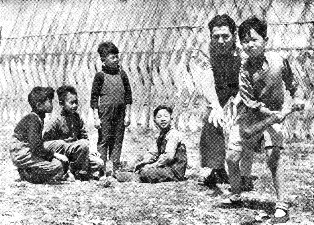


VOL. II NO. 39 REG NO. L5015 DELHI, THURSDAY JUNE 8, 1944
 Some people aee spots before their eys when they're non-existent. Here's reversing the procedure. It may take you some
time to notice the spots, for there are - er - other such interesting things to look at first. RKO's Chili Williams
models a bathing suit in which she'll appear in Having A Wonderful Crime, her movie debut.
Some people aee spots before their eys when they're non-existent. Here's reversing the procedure. It may take you some
time to notice the spots, for there are - er - other such interesting things to look at first. RKO's Chili Williams
models a bathing suit in which she'll appear in Having A Wonderful Crime, her movie debut.
|
NORTHERN BURMA - Each day this week dawned with dimmer hope for the Japanese in Northern Burma. Tighter Allied rings were drawn around the besieged garrisons of Myitkyina and Kamaing; and the Chinese push west of the Salween River continued successfully against bitter opposition. It became more evident this week that the enemy has been caught in a nutcracker by Lt. Gen. Joseph W. Stilwell's polyglot forces.
In bitter fighting that cost the Japanese 2,000 killed - including a commanding major general - the Chinese captured Tatengtzu in the Salween drive and then pushed 14 miles toward Tengchung, now 12 miles distant.
Capture of strategically-important Tengchung, situated on the Myitkyina-Lashio Highway, would put the Chinese 20 miles west of the Burma Road and only 50 miles due east of Myitkyina.
meanwhile, some of the most savage fighting of the Salween campaign is taking place at Chiautou, with possession changing hands several times during the week. Chinese forces held the town for three days, but vicious enemy counter-attacks have forced them to withdraw.
The 14th Air Force's weight was put behind the Chinese. Besides dropping 28 tons of bombs on Lashio and carrying out raids upon Lungling, the Burma Road, the mamien Pass area and other targets. Maj. Gen. Claire L. Chennault's airmen also succeeded in cutting the Burma Road, which has been the Japs' main supply artery. At the same time, planes dropped much needed supplies to the advancing Chinese.
Myitkyina Holds Another Week
Myitkyina still held this week, but the stubborn perimeter of Jap resistance was being squeezed into a diminishing arc within the shattered town bordering on the Irrawaddy River. Advances were made from both north and south by Chinese-American forces, with the railroad station, held 15 days earlier, finally recaptured by Chinese driving from the south.
More trouble for the Japanese arrived with the appearance of a force of Chindits which is now hammering at Waingmaw, northern terminus of the road from Bhamo. Waingmaw is four miles south of Myitkyina along the twisting Irrawaddy and is northeast of Zigyun.
In the Mogaung Valley, the Chinese this week completed their encirclement of Kamaing with spearhead forces; and the main body hammered southward toward the Jap bastion after liquidating the tough enemy knot of resistance at Malakawng, which had held stubbornly for three weeks.
Swiftly, the Chinese took positions at the Kamaing-Malakawng-Lonkin road intersection near Pakhren Sakan, four miles north of Kamaing. Jap artillery and a counter-attack has failed so far to dislodge them.
South of Kamaing, the road block grabbed last week held stoutly. Astride the Jap lines of river and road communication below the town, the Chinese strengthened their position by the capture of the village of Seton, the rebuff of enemy counter-attacks and the seizure of horses, artillery, motor vehicles, supplies and equipment.
Seven miles west of Kamaing, Chinese units clamped a hold on Hkumgahtawng along the Sebu River and east of Kamaing other forces appeared at an undesignated road junction.
The main Chinese force was last reported three and one-half miles south of Mataing Sakan along the main Mogaung Valley road at a point seven and one-half miles above Kamaing.
A force of Chindits was reported to have appeared at a hill feature southeast of Moguang.
In the Fort Hertz Valley, Nsopzup, between Myitkyina and Sumprabum, was again raided by Levies, who also ambushed a party of Japs moving west from Kairingkawng and installed a road block south of Tiangzup.
Seven hundred Jap killed were claimed by the Chindits before abandonment of their road block southwest of Mogaung last week.
British Forces Clearing Japs Out Of Kohima
KANDY - British forces cleaned up the last pocket of Japanese resistance in Kohima this week-end and forced the enemy to retire from several positions northwest of the village, according to SEAC Headquarters.
The Japanese still hold some high ground in the Kohima area, however, and British forces continued their offensive efforts to clear the sector. The monsoon has officially broken, according to SEAC experts, and heavy rains are drenching the mountain battlefield.
To the south, where the Japanese made a last stab at the important supply base at Imphal two weeks ago, the British still held the offensive this week. British and American aircraft, whenever the weather permitted, supported British troops slowly forcing the Japanese out of strong points in the Bishenpur, Tiddim, and Ukhral areas.
Japanese strength in the entire central Indo-Burma border area seemed on the decline, as counter-attacks became less and less frequent and Japanese casualty figures continued to grow.
"Step this way, men. Get your money orders, stamps, envelopes," MacFarland announced.
For the next two hours, mean appeared from all points of the compass to take advantage of postal facilities for the first time in months. When the last jungle-stranded G.I. had purchased his stamps and envelopes, or pocketed a money order, the Post Office closed its doors and went lumbering toward Combat Trail in search of other "lost battalions."
The trip was the inaugural of a new service which will make all mail facilities available to isolated units south of Shingbwiyang.
The truck is a mailman's Shangri-La. Constructed specially at a West India Port, it is equipped with everything but murals - letter cases, tables, sack rack, letter box and lighting unit.
Truth Stranger Than Fiction
ALONG THE LEDO ROAD - He swears it's true. And was dripping with evidence to prove it. Capt. D. M. Steiner, CO of a trucking company operating along the Ledo Road, spiralled down the mountainous highway in a pouring rain. As he entered a small valley, the sun came out, strong and hot. Presently clouds of steam and vapor rose from the sodden ground, hung overhead, turned gray and ominous. You guessed it. Rain poured forth and drenched the earth all over again.
COCHRAN IN STATES
To Report On Air Commandos
WASHINGTON (UP-ANS) - Daring, hell-for-leather Col. Philip G. Cochran, 33-year-old Air Commando leader, had returned to the United States this week from Burma to make a report to Gen. Henry H. Arnold, Commander of the Army Air Forces.
Cochran was quoted as declaring that "we have only scratched the surface of the possibility of moving armies by air," citing as proof the Chindits, which were moved into Burma by his spectacular unit and then supplied successfully by air.
Relating the ferocity of jungle fighting in Burma, Cochran described how often one end of an airstrip would be held by the British and the other end by the Japs and that "sometimes when a liaison plane took off it was shot down at the other end of the strip."
The Air Commando leader (thinly disguised as 'Flip Corkin' in Milt Caniff's Terry and the Pirates) described how his fighter planes were used by the Chindits as artillery. "They would see the target, mark it and then call on us," he said. "They just about led us by the hand."
AIR FORCE MERGER TO BE ASKED SOON
WASHINGTON (ANS) - Sen. Lister Hill (D-Ala.) announced this week that he will shortly introduce legislation giving the Air Forces equal footing with the Army and Navy in a new combined "Department of Air Forces."
The Associated Press described Hill as announcing he was acting on his own responsibility in proposing the abolition of the present War and navy Departments and substitution of a combined agency six months after the war.
War Department spokesman have endorsed the move to form a single department after the war, while Navy officers have expressed opposition to the idea.
 "Everytime Louie sleeps in an upper bunk he dreams he's a Flying Tiger."
"Everytime Louie sleeps in an upper bunk he dreams he's a Flying Tiger."
|
EAC HEADQUARTERS - Throughout the week, air operations against the Japanese over Burma were considerably hampered by storms, clouds and adverse weather generally. In spite of this, however, fighters and fighter-bombers of the Third Tactical Air Force, EAC, were successful in providing almost continuous air support for ground troops in the Myitkyina and Kohima areas.
Enemy artillery positions, revetments, machine gun nests and lines of communications near Myitkyina were under almost constant attack.
On May 31, P-40's and P-51's bombed and strafed enemy positions from dawn to dusk, flying more than 200 sorties during the day. Close liaison between ground and air units during these operations contributed greatly to the success of the attacks.
VENGEANCES ACTIVE
On the same day, in support of the Fourth Corps in the Imphal area, Vengeances carried out successful dive bombing missions against an ammunition dump at Ukruhl. The initial explosion was followed by a large number of fires in the dump area.
Weather also hampered the operation of long-range fighters and bombers into central Burma. On one mission to the Chauk-Prome area, however, heavy fighters damaged 23 river craft.
STORM CONDITIONS
During the week, storms and cloud conditions interfered considerably with the operation of heavy and medium bombers of the Strategic Air Force. Throughout this period, USAAF B-24's and B-25's bombed Bhamo, starting a number of fires and causing three explosions. Later on this same mission, Mitchells strafed Sangkin and caused 10 fires, with black smoke rising to 1,500 feet.
On May 31, B-25's scored three direct hits on the railroad bridges at Wingwi and Kathitkon. The previous day, these same planes made 24 direct hits on a railroad bridge near Thytyabin.
16 MORE JAP SHIPS SUNK BY U.S. FLEET
WASHINGTON (ANS) - The United States has sent 16 more Jap merchant ships to the bottom while ranging the Pacific and Far Eastern supply lines, the Navy announced this week. Some 589 Jap ships have now been sunk by American submarines.
Chinese Slow Jap Advance
CHUNGKING - Chinese troops this week slowed the Japanese advance on Changsha, the capital of Hunan, according to the Chinese Army spokesman.
The Japanese drive into Free China from Canton and Hankow, according to reports reaching here, is aimed at the occupation of American bases and the control of the long-contested Canton-Hankow railroad. The Army spokesman estimated the Japanese had massed 280,00 troops in the Canton and Hankow areas for an offensive which they hope will prevent the Allies from using China as a base for future attacks on Japan's China holdings.
The fighting this week was confused, spreading over three provinces, Hunan, Honan and Hupeh. The Chinese were putting up stiff resistance to the steady Japanese advance. American 14th Air Force planes joined aircraft of the Chinese Air Force in attacking Japanese lines of communications over the wide front. The Japanese retaliated with heavy raids on American air bases, attacking one field 14 times in one 24-hour period.

|
Solving Of Enigma CBI Problem
Comes now, oh, joy, the hot season and, with it, the absorbing question: "What can I do about it?"
The solving of that enigma, chum, is the $64 answer to end all $64 answers.
About all you can do is sweat it out, but literally.
You can never really get cool when the mercury bubbles merrily in the thermometer tube and inches perilously close to the top
But there are several ingenious artifices which help somewhat to alleviate the scorched earth policy adopted by Old Sol in this neck of the world.
One of these is the khuss-khuss, a mat of woven grass which, when wetted, magically transforms the air passing through it into a refreshing spring breeze.
At least, that is the theory. It works out differently, of course, in actual practice. First, there must be a breeze (Pardon our hollow, croaking laugh). Second, we suppose that your bhistis (water boys) are much like ours, which means that your khuss-khuss remains brown and sere and that the interior of your room is remindful of a Bessemer Furnace.
The bhisti has a positive genius for disappearing into thin air and lends some creedence to the much-ridiculed claim that some Indians possess the knack of climbing up a rope and pulling it up after them. Either that, or he is sleeping so soundly that Rip Van Winkle could take lessons in the gentle art of relaxation.
During his few moments of wakefulness, the bhisti has one all-engrossing interest. Unfortunately, this is not to get on with his work but, rather, to mooch cigarettes from the sahibs he has so shamefully neglected. In the sparse hope that a smoke may spur him into action, the cigarette is given. But instead of the pleasing sound of water splashing against the khuss-khuss, there is generally only the even, modulated polyphony of his snore to disturb the fetid summer air.
Fellow martyrs who suffered through last summer remember still another unpleasant aspect. That would be prickly heat, of course.
One of the redeeming features of prickly heat is that it welds all walks of military life, from private to general, from Quartermaster to Infantry, into one strong, sympathetic bond. Prickly heat knows no favorites.
The cures for prickly heat are numerous. But all have one basic factor in common - none of 'em work. We know one chap who, at summer's end, had so many sure-fire nostrums stacked up under his bunk that he poured them into a bucket. The result was startling. The bucket jitter-bugged down the road whistling Mairzy Doats, took off with theverve of a B-25 and exploded in mid-air. He's still trying to recall the formula, believing the concoction would be more pleasing to the palate than Fighter Brand Whisky, with the same internal reactions.
Yet another feature of a CBI summer is the advent of tropical wearing apparel, particularly shorts and topees.
It will forever remain a mystery to us why the Yank sahibs who are physically worst equipment for shorts are the principal devotees of these hacked-down pants. From our observations, the requirements appear to be either (a) a pair of knobby knees a la Sir harry Lauder or (b) a rumble seat of generous proportion. For shame, gentlemen.
The various styles of topees are intriguing. Some fit rakishly on the top of the noggin like a beret; others lovingly drape themselves around the wearers' ears. Never in a zillion years, we submit, will the Yank be able to accoutre himself in a topee with the calm, unruffled dignity of the pucca British sahib.
And so with the sweet, soothing strains of Indian Summer gently assuaging our ears, the Roundup leaves you until this same time next Thursday.
 At an American Y-Force base in China, enjoying a brief lull in the war against the Japanese an American soldier
is having the "time of his life" in teaching baseball to his young Chinese friends. T/5 Earl hayden, Greenup, Ill.,
is the instructor, and from the looks on their faces the Chinese youngsters enjoy baseball as much as the lads back
in Clayton, Mo., Peoria, Ill., or Sacremento.
At an American Y-Force base in China, enjoying a brief lull in the war against the Japanese an American soldier
is having the "time of his life" in teaching baseball to his young Chinese friends. T/5 Earl hayden, Greenup, Ill.,
is the instructor, and from the looks on their faces the Chinese youngsters enjoy baseball as much as the lads back
in Clayton, Mo., Peoria, Ill., or Sacremento.
|
TWO G.I'S HELP DAN'L CUPID
INDIA AIR DEPOT - This week's India Ink, station newspaper, reports how Cupid was aided and abetted by T/5 Steve Cancro, Bronx, N.Y., and Pfc. Jerry Schaeffer, Newark, N.J.
Durga Pasa, their slim 16-year-old bearer, came to the two sahibs with his plight. He was desirous of being married, but alas, hadn't the customary Rs. 150 required to pay off his prospective father-in-law.
The two understanding sahibs dug into their jeans for the money and jealously refused the offer of the other members of their company to chip in, proclaiming, "Get your own bearer married."
In the meantime, the men of Barracks 9 prepared to attend Durga Pasa's venture into matrimony to be held at a neighboring village.
ONE-HALF ARMY OVERSEAS
STIMSON SAYS DECISIVE ACTION AT HAND
WASHINGTON (ANS) - Nearly half of the U.S. Army's strength is either in action against the enemy or in combat zones preparing for new offensives, Secretary of War Henry L. Stimson revealed this week in announcing that 3,657,000 soldiers are overseas.
"The period of decisive action is at hand," he declared.
Figures released by Stimson showed that the AAF has 75,000 planes, including 34,000 combat craft, and is operating 925 bases on foreign soil, including 750 airfields.
INVADERS STORM NORMANDY COAST
Given Order Of Day By Eisenhower
LONDON - Before the assaulting troops embarked on the invasion of Hitler's Fortress Europa, each man was handed a stirring Order of the Day from Gen. Dwight Eisenhower which, in part, read:
"You are about to embark upon the great crusade towards which we have stiven these many months. The eyes of the world are upon you. The hopes and prayers of liberty-loving people everywhere march with you. In company with our brave allies and brothers-in-arms on other fronts, you will bring about the destruction of the German war machine, the elimination of Nazi tyranny over oppressed peoples of Europe and security for ourselves in a free world. Your task will not be an easy one. Your enemy is well trained, well equipped and battle hardened. But this is the year 1944. Much has happened since the Nazi triumphs of 1940 to 1941. The tide has turned. Free men of the world are marching together toward victory. Good luck. And let us all beseech the blessing of the Almighty God upon this great and noble undertaking."
The C.B.I. Roundup is a weekly newspaper published by and for the men of the United States Army Forces in China, Burma, and India, from news and pictures supplied by staff members, soldier correspondents, the United Press, and the Army News Service. The Roundup is published Friday of each week and is printed by The Statesman in New Delhi, India. Editorial matter should be sent directly to Lt. Floyd Walter, Rear Echelon Hq., U.S.A.F., C.B.I., New Delhi, and should arrive not later than Monday in order to make that week's issue. Pictures must arrive by Sunday and must be negatives or enlargements. Stories should contain full name and organization of sender.

JUNE 8, 1944
Original issue of C.B.I. Roundup shared by Virginia Dyer, widow of CBI veteran Stanley Dyer.
Copyright © 2006 Carl Warren Weidenburner
TOP OF PAGE PRINT THIS PAGE ABOUT THIS PAGE SEND COMMENTS
PREVIOUS ISSUE CLOSE THIS WINDOW NEXT ISSUE